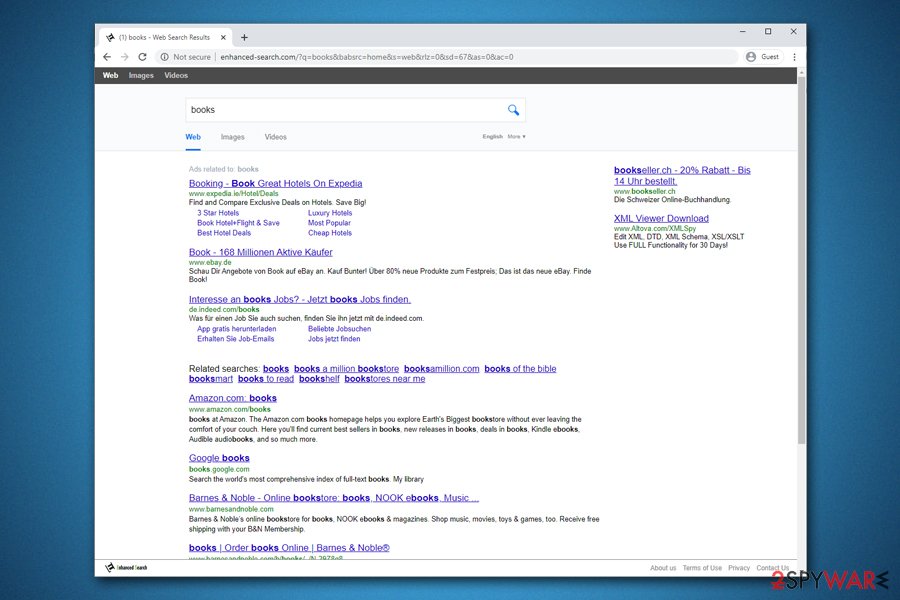Enhanced Search (Removal Guide) - updated Jan 2020
Enhanced Search Removal Guide
What is Enhanced Search?
Enhanced Search is a browser hijacker created to generate money from sponsored content displayed to users

Enhanced Search is a browser hijacker[1] that typically spreads as a browser extension for Google Chrome, Mozilla Firefox, Safari, or Internet Explorer. Created by an Israeli-based company Babylon Ltd., it is one of many browser hijackers that claims to “enhance the search results and quickly help users find what they are looking for.” However, the Enhanced Search is usually installed without asking for direct user permission and focuses on directing users to affiliated sites and displaying ads.
Once installed, Enhanced Search sets the homepage and the new tab address of the web browser to enhanced-search.com, which also appends a customized search engine. As a result, most of the users input their search queries via a hijacked engine, which returns altered search results, i.e., sponsored links and ads are the ones that users see first, and organic results are displayed below. Each click on sponsored links guarantees Enhanced Search developers profit – all while users must battle the unwanted ads.
| Name | Enhanced Search |
| Type | Browser hijacker, potentially unwanted program |
| Developer | Israeli company Babylon Ltd. |
| Homepage | enhanced-search.com |
| Distribution | Potentially unwanted programs are usually propagated via software bundle packages or downloaded intentionally from third-party websites |
| Symptoms | Homepage, new tab URL is set to enhanced-search.com, a customized search engine applied, sponsored links plague search results, ads appear on sites that usually don't show them, etc. |
| Dangers | Installation of other potentially unwanted programs, sensitive data disclosure, malware infection, etc. |
| Removal | Use anti-malware program capable of detecting PUPs or delete the app manually – follow the guide in our removal section |
| Recovery & optimization | For best results, we recommend resetting all the installed browsers as per instructions below and scanning the machine with repair software FortectIntego |
Browser hijackers were extremely popular in the late 2000s and early 2010s, as users were still unaware of what activities toolbars, browser extensions, and other useless programs perform. Each of these add-ons would augment browsers with a search bar, each of which would serve ads regardless of the provided search engine is used. As a result, users' browsers were cluttered, and quite often, such toolbars and add-ons were dangerous, leading users to malware-laden or scam sites. It is not surprising that terms like “Enhanced Search virus” were prevalent at the time.
Essentially, a virus is a malicious program that uses system or application files to propagate, infecting, and sometimes taking over the computer system entirely. While it is not the case with browser hijackers, the rerouting tendencies, mysterious (and sudden) change of the homepage and new tab cause many to get convened – and for a reason. Unfortunately, Enhanced Search removal might not be as simple as it might seem, as some developers program the add-on to be grayed out once it is implemented, which complicates everything for regular users.

In some cases, EnhancedSearch.com might be installed as a standalone application that must be uninstalled via the Control Panel or Applications folder on Macs. However, the persistent extensions might require a browser reset or, in some cases, even a scan with anti-malware software. In any case, if you found an unwanted extension on your browser, you should check the instructions we provide below. As for system optimization and recovery after the infection, we also suggest using FortectIntego.
Those who decide to keep the Enhanced Search PUP installed on their system should be aware that persistent ads and sponsored links are not the only activity the hijacker performs. In the background, a particular set of information is collected with the help of cookies and other tracking technologies in order to feed users targeted ads.[2] It includes:
- Operating system information
- Installed browsers and their versions
- Country of origin
- Search terms
- Sites visited, etc.
Luckily, the popularity of such browser hijackers like EnhancedSearch.com greatly diminished, as modern browsers became safer – they now notify about changes that an external source is trying to make, and users can decline them with just one click. However, you should also remember that you need to remove Enhanced Search hijacker from your machine regardless if you accepted the change or not, or it will continue its background activities.
Note that Babylon Ltd. has created multiple other browser hijackers that work identically (for example, Opti-Page.com, Clean.shield-plus.com, Search.movies-tab.com, and many others) – enter users' computers without permission, alter web browser settings, show non-organic search results, and display other commercial content during web browsing sessions.
All in all, do not trust the “search result enhancing” programs like EnhancedSearch.com, as they bring no value apart from intrusive advertisements, and might also lead to unsafe sites in some cases, resulting in money loss, malware infections, or other unfavorable consequences.
Potentially unwanted programs are hidden inside software bundles – here's how to avoid them
Users mostly install potentially unwanted programs unintentionally while browsing third-party freeware sites. The practice lingers from early software days when not many official sources for apps were available – sites like Download.com, Softonic, and others, flourished. These sites are often filled with multiple download buttons and other confusing traits that make users download and install software they never intended to in the first place. You might want to ask why they would do such a thing? The answer is simple – money. Add developers can pay for particular promotion campaigns on the site, and might also ask site owners to insert the app into some installers distributed there.

The deception does not end there, however. Once the installation wizard is launched, users are often presented with installation instructions that are confusing, include pre-ticked boxes, hidden components that are not visible without picking Advanced/Custom settings, misleading offers, deceptive button placements, and similar tricks. Therefore, if you still feel the need to download software from third-parties (especially torrent sites), despite the fact that legitimate sources have almost 2.5 million apps available,[3] you should be extremely careful and check each of the installation steps in detail.
Note that even Google cannot completely protect its stores from malicious applications,[4] and third-party sites do not have the resources to perform such extensive security checks. Thus, employ anti-malware software and be cautious when downloading new apps.
Remove Enhanced Search virus from your computer
As we have mentioned before, Enhanced Search is not classified as a malicious program; nevertheless, if you would decide to keep this search engine installed on each of your web browsers (it may affect Google Chrome, Mozilla Firefox, Safari, and other browsers), you might be forced to visit sponsored sites that might sometimes not be what you are looking for or, provide a low-quality content.
Therefore, we suggest you remove Enhanced-search.com from your computer and use legitimate search engines that do not fill ear searches with ads and rather trust well-developed search engine mechanisms that are continually improved by tech giants like Google. If you want privacy, employ privacy-focused browsers like Mozilla Firefox or Tor.
Enhanced Search removal should not be that difficult – you can find all the relevant information below. Besides, security experts[5] recommend resetting all the installed browsers after their hijacking, as altered settings might continue the unwanted behavior.
You may remove virus damage with a help of FortectIntego. SpyHunter 5Combo Cleaner and Malwarebytes are recommended to detect potentially unwanted programs and viruses with all their files and registry entries that are related to them.
Getting rid of Enhanced Search. Follow these steps
Uninstall from Windows
To terminate potentially unwanted programs from Windows, follow these instructions:
Instructions for Windows 10/8 machines:
- Enter Control Panel into Windows search box and hit Enter or click on the search result.
- Under Programs, select Uninstall a program.

- From the list, find the entry of the suspicious program.
- Right-click on the application and select Uninstall.
- If User Account Control shows up, click Yes.
- Wait till uninstallation process is complete and click OK.

If you are Windows 7/XP user, proceed with the following instructions:
- Click on Windows Start > Control Panel located on the right pane (if you are Windows XP user, click on Add/Remove Programs).
- In Control Panel, select Programs > Uninstall a program.

- Pick the unwanted application by clicking on it once.
- At the top, click Uninstall/Change.
- In the confirmation prompt, pick Yes.
- Click OK once the removal process is finished.
Delete from macOS
Remove items from Applications folder:
- From the menu bar, select Go > Applications.
- In the Applications folder, look for all related entries.
- Click on the app and drag it to Trash (or right-click and pick Move to Trash)

To fully remove an unwanted app, you need to access Application Support, LaunchAgents, and LaunchDaemons folders and delete relevant files:
- Select Go > Go to Folder.
- Enter /Library/Application Support and click Go or press Enter.
- In the Application Support folder, look for any dubious entries and then delete them.
- Now enter /Library/LaunchAgents and /Library/LaunchDaemons folders the same way and terminate all the related .plist files.

Remove from Microsoft Edge
You should reset MS edge as soon as you remove Enhanced Search and other potentially unwanted apps:
Delete unwanted extensions from MS Edge:
- Select Menu (three horizontal dots at the top-right of the browser window) and pick Extensions.
- From the list, pick the extension and click on the Gear icon.
- Click on Uninstall at the bottom.

Clear cookies and other browser data:
- Click on the Menu (three horizontal dots at the top-right of the browser window) and select Privacy & security.
- Under Clear browsing data, pick Choose what to clear.
- Select everything (apart from passwords, although you might want to include Media licenses as well, if applicable) and click on Clear.

Restore new tab and homepage settings:
- Click the menu icon and choose Settings.
- Then find On startup section.
- Click Disable if you found any suspicious domain.
Reset MS Edge if the above steps did not work:
- Press on Ctrl + Shift + Esc to open Task Manager.
- Click on More details arrow at the bottom of the window.
- Select Details tab.
- Now scroll down and locate every entry with Microsoft Edge name in it. Right-click on each of them and select End Task to stop MS Edge from running.

If this solution failed to help you, you need to use an advanced Edge reset method. Note that you need to backup your data before proceeding.
- Find the following folder on your computer: C:\\Users\\%username%\\AppData\\Local\\Packages\\Microsoft.MicrosoftEdge_8wekyb3d8bbwe.
- Press Ctrl + A on your keyboard to select all folders.
- Right-click on them and pick Delete

- Now right-click on the Start button and pick Windows PowerShell (Admin).
- When the new window opens, copy and paste the following command, and then press Enter:
Get-AppXPackage -AllUsers -Name Microsoft.MicrosoftEdge | Foreach {Add-AppxPackage -DisableDevelopmentMode -Register “$($_.InstallLocation)\\AppXManifest.xml” -Verbose

Instructions for Chromium-based Edge
Delete extensions from MS Edge (Chromium):
- Open Edge and click select Settings > Extensions.
- Delete unwanted extensions by clicking Remove.

Clear cache and site data:
- Click on Menu and go to Settings.
- Select Privacy, search and services.
- Under Clear browsing data, pick Choose what to clear.
- Under Time range, pick All time.
- Select Clear now.

Reset Chromium-based MS Edge:
- Click on Menu and select Settings.
- On the left side, pick Reset settings.
- Select Restore settings to their default values.
- Confirm with Reset.

Remove from Mozilla Firefox (FF)
Remove dangerous extensions:
- Open Mozilla Firefox browser and click on the Menu (three horizontal lines at the top-right of the window).
- Select Add-ons.
- In here, select unwanted plugin and click Remove.

Reset the homepage:
- Click three horizontal lines at the top right corner to open the menu.
- Choose Options.
- Under Home options, enter your preferred site that will open every time you newly open the Mozilla Firefox.
Clear cookies and site data:
- Click Menu and pick Settings.
- Go to Privacy & Security section.
- Scroll down to locate Cookies and Site Data.
- Click on Clear Data…
- Select Cookies and Site Data, as well as Cached Web Content and press Clear.

Reset Mozilla Firefox
If clearing the browser as explained above did not help, reset Mozilla Firefox:
- Open Mozilla Firefox browser and click the Menu.
- Go to Help and then choose Troubleshooting Information.

- Under Give Firefox a tune up section, click on Refresh Firefox…
- Once the pop-up shows up, confirm the action by pressing on Refresh Firefox.

Remove from Google Chrome
Delete malicious extensions from Google Chrome:
- Open Google Chrome, click on the Menu (three vertical dots at the top-right corner) and select More tools > Extensions.
- In the newly opened window, you will see all the installed extensions. Uninstall all the suspicious plugins that might be related to the unwanted program by clicking Remove.

Clear cache and web data from Chrome:
- Click on Menu and pick Settings.
- Under Privacy and security, select Clear browsing data.
- Select Browsing history, Cookies and other site data, as well as Cached images and files.
- Click Clear data.

Change your homepage:
- Click menu and choose Settings.
- Look for a suspicious site in the On startup section.
- Click on Open a specific or set of pages and click on three dots to find the Remove option.
Reset Google Chrome:
If the previous methods did not help you, reset Google Chrome to eliminate all the unwanted components:
- Click on Menu and select Settings.
- In the Settings, scroll down and click Advanced.
- Scroll down and locate Reset and clean up section.
- Now click Restore settings to their original defaults.
- Confirm with Reset settings.

Delete from Safari
Remove unwanted extensions from Safari:
- Click Safari > Preferences…
- In the new window, pick Extensions.
- Select the unwanted extension and select Uninstall.

Clear cookies and other website data from Safari:
- Click Safari > Clear History…
- From the drop-down menu under Clear, pick all history.
- Confirm with Clear History.

Reset Safari if the above-mentioned steps did not help you:
- Click Safari > Preferences…
- Go to Advanced tab.
- Tick the Show Develop menu in menu bar.
- From the menu bar, click Develop, and then select Empty Caches.

After uninstalling this potentially unwanted program (PUP) and fixing each of your web browsers, we recommend you to scan your PC system with a reputable anti-spyware. This will help you to get rid of Enhanced Search registry traces and will also identify related parasites or possible malware infections on your computer. For that you can use our top-rated malware remover: FortectIntego, SpyHunter 5Combo Cleaner or Malwarebytes.
How to prevent from getting browser hijacker
Stream videos without limitations, no matter where you are
There are multiple parties that could find out almost anything about you by checking your online activity. While this is highly unlikely, advertisers and tech companies are constantly tracking you online. The first step to privacy should be a secure browser that focuses on tracker reduction to a minimum.
Even if you employ a secure browser, you will not be able to access websites that are restricted due to local government laws or other reasons. In other words, you may not be able to stream Disney+ or US-based Netflix in some countries. To bypass these restrictions, you can employ a powerful Private Internet Access VPN, which provides dedicated servers for torrenting and streaming, not slowing you down in the process.
Data backups are important – recover your lost files
Ransomware is one of the biggest threats to personal data. Once it is executed on a machine, it launches a sophisticated encryption algorithm that locks all your files, although it does not destroy them. The most common misconception is that anti-malware software can return files to their previous states. This is not true, however, and data remains locked after the malicious payload is deleted.
While regular data backups are the only secure method to recover your files after a ransomware attack, tools such as Data Recovery Pro can also be effective and restore at least some of your lost data.
- ^ Browser Hijacker. SearchSecurity. Information Security information, news and tips.
- ^ Targeted advertising. Wikipedia. The free encyclopedia.
- ^ Number of apps available in leading app stores as of 3rd quarter 2019. Statista. Satistics portal.
- ^ Zak Doffman. New Android Threat: Google Confirms Malicious Apps Removed From Play Store—Uninstall Now. Forbes. American business magazine.
- ^ Lesvirus. Lesvirus. Malware news and cybersecurity insights.























